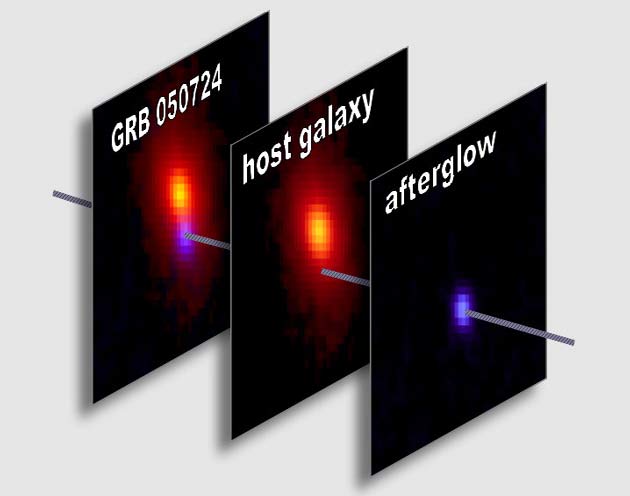Black Hole Swallows Neutron Star, Observations Suggest

A distant eruption of high-energy gamma rays is evidence for a black hole swallowing another dense object called a neutron star, astronomers announced today.
A neutron star is a stellar corpse with a mass equal to a few suns packed into a space no more than 12 miles across. Black holes are even denser objects, so dense that matter and even light can't escape once inside their spheres of invisible influence.
Scientists have long suspected collisions between these objects are common. Other recent bursts have looked similar, but observations from NASA's orbiting Swift satellite and other telescopes, recorded July 24 and reported in the Dec. 15 issue of the journal Nature, are the most detailed.
Astronomers speculated about what might have happened.
"For billions of years, this black hole and neutron star orbited each other in a gravitational tug-of-war," said Scott Barthelmy of NASA Goddard Space Flight Center. "The neutron star lost."
The flash of gamma rays lasted just a few milliseconds. Afterglows of X-rays, radio waves, visible and infrared light were detected thereafter.
The afterglows are an important clue.
Get the Space.com Newsletter
Breaking space news, the latest updates on rocket launches, skywatching events and more!
Barthelmy and colleagues figure the neutron star was stretched into a crescent shape as "crumbs" broke off. The black hole might have swallowed the bulk of the neutron star in one gulp, while the other chunks were consumed in the hours that followed. Each bite generated radiation.
If the event, named GRB 050724, had been a merger between two neutron stars, there wouldn't have been so many crumbs left over. The two objects would smash, instantly form a black hole, and after a modest afterglow no more light would be seen, the astronomers theorize.
Colliding black holes likewise should not generate much afterglow.
Longer gamma-ray bursts, lasting seconds, are thought to signal the deaths of massive stars at the ends of their normal lives.
"There's only one thing I know of that could rip apart a neutron star with bits flying out, and that's a black hole," said one of the study's co-authors, Peter Meszaros of Penn State University. "Now we have the first evidence that this might actually be occurring."
The apparent merger took place in the outskirts of an old, mostly dead galaxy known to be loaded with neutron stars and black holes. That further suggests the event was not related to a stellar explosion, which would be more likely to occur in a young, star-forming galaxy.
- Neutron Star Collisions Common, Study Suggests
- Astronomers Take Measure of City-Sized Neutron Star
- Closest Known Neutron Star Races Across Sky
- Runaway Star Collisions Create Black Holes
Join our Space Forums to keep talking space on the latest missions, night sky and more! And if you have a news tip, correction or comment, let us know at: community@space.com.

Rob has been producing internet content since the mid-1990s. He was a writer, editor and Director of Site Operations at Space.com starting in 1999. He served as Managing Editor of LiveScience since its launch in 2004. He then oversaw news operations for the Space.com's then-parent company TechMediaNetwork's growing suite of technology, science and business news sites. Prior to joining the company, Rob was an editor at The Star-Ledger in New Jersey. He has a journalism degree from Humboldt State University in California, is an author and also writes for Medium.









